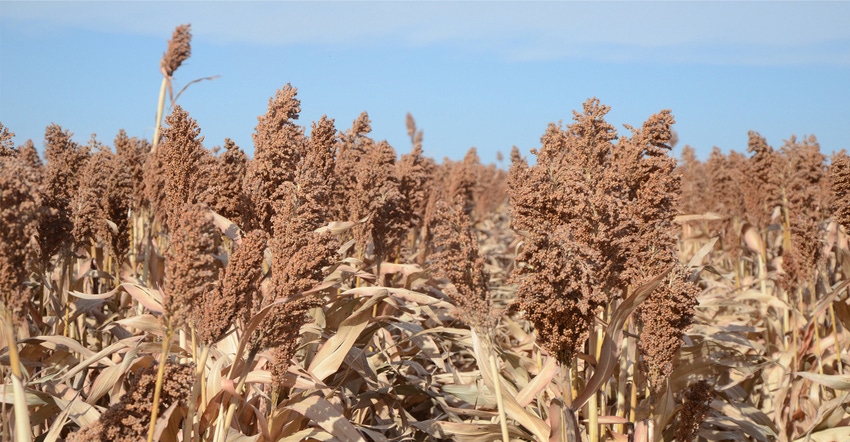August 16, 2019

Editor's note: This is the last in a series of articles provided by the Nebraska Grain Sorghum Board on integrating grain sorghum into crop and livestock operations in Nebraska.
By Nate Blum
Sorghum is often referred to by the name "milo," which is the variety most Americans are familiar with. We've been growing milo in America for generations. It is a versatile crop, and its uses are myriad.
Sorghum is used in everything from luxury culinary goods for human consumption, aquaculture, livestock feed, pet food, ethanol, and even in a Chinese spirit called "baijiu."
Sorghum is an excellent addition to sustainable farm operations. In rotation, sorghum promotes improved soil structures and microbiology, which means less fertilizer will be needed when another crop is rotated the next year. In fact, producers often see an average of 8% increase in corn yields when planted after sorghum.
Sorghum uses one-third to half the amount of water used by comparable cash crops, which is attractive to producers concerned with maintaining and replenishing their water supply. Including sorghum in crop rotations also breaks disease and pest cycles in other crops.
For the producer, sorghum allows for substantially lower input costs and increased revenues if marketed correctly. Because the applications for the product are varied, producers should contact end users before planting, in order to determine what variety of sorghum their customer requires.
Determining what variety, and quantity, of sorghum required by the end user often allows growers to obtain contracts for their grain, mitigating market volatility risk. If additional steps are taken, such as satiating the increasing demand for traceability in food systems, the crop can be sold at a far higher premium than the market price producers are accustomed to.
Consumer interest in sorghum has grown, particularly on the East and West coasts. The grain is best described as similar to quinoa, but larger. The product, which can be cooked as a grain, baked as a flour and even made into noodles, is gluten free, non-GMO and rich in antioxidants.
Unlike quinoa, sorghum is raised in the Midwest. This allows for cheaper transportation costs, which is attractive to wholesalers such as Costco.
Sorghum has made the difference for producers such as Jimmy Fletcher, Travis Dunekacke and Dean Dvorak. Because they added sorghum to their operations, they have been able to provide for their families while increasing revenue, despite challenging conditions in agriculture.
Theirs are inspiring stories of success that come from listening directly to consumer demand, a concept not so uncommon in other industries, but historically limited within traditional agriculture.
The American agricultural system now stands at a crossroads. The "traditional" model of treating grain production as a commodity incentivizes growers to increase yields in hopes of increasing profit. Ironically, as more grain floods the commodity markets, the price the producer receives for their product declines. Increased supply does not always translate into increased demand.
Additional turmoil surrounding commodity trading to international partners, such as China, creates more uncertainties. Commodity farming leaves the producer little control over prices in a volatile market.
Rather than raising more crops and selling them for less profit, successful agriculturalists must begin to consider how to increase revenues without depending on increasing yields. This means working directly with end users to put grain under contract before planting a single seed. In addition, it is in the best interest of producers to connect directly with the average consumer, many of whom are disconnected from agricultural systems.
About 2% of the population in America is now directly linked to production agriculture. Conversely, 98% of the population does not have everyday access to food production systems. It is no secret in the ag community that this disconnection among the American populace has generated confusion and misinformation regarding agricultural production in general.
The bottom line is members of the agricultural community, most of whom act as good stewards of the Earth and their livestock out of necessity for preserving their livelihood, feel under assault.
While it is a natural reaction to respond to propagated fictions with animosity, doing so only further reinforces those misconceptions in the minds of the very consumers whom the producer needs to reach.
In other words, no one ever won an argument by arguing. Instead, modern producers can benefit from listening to the demands of the consumer, validating their right to their beliefs, and then delivering a product that assuages consumer concerns.
While doing so, it is incumbent upon the producer to tell their story in a positive and enthusiastic way. Digital media platforms such as Instagram, Facebook, LinkedIn, Twitter and YouTube provide growers with mediums with larger audiences than possible in the past, and with greater ease of access.
The agriculture industry will never win all the hearts and minds of American consumers. However, by approaching the general population with a spirit of partnership rather than enmity, we can begin to renew the integral connection between rural and urban America.
To learn more, visit nebraskasorghum.org.
Blum is executive director of the Nebraska Grain Sorghum Board.
Source: Nebraska Grain Sorghum Board, which is solely responsible for the information provided and is wholly owned by the source. Informa Business Media and all its subsidiaries are not responsible for any of the content contained in this information asset.
You May Also Like




